 Latin American Light Product Imports Level Off/Decline
Latin American Light Product Imports Level Off/Decline
Latin American oil demand is downshifting in 2016 with gasoline expected to grow only slightly and diesel to contract. Product imports into the region are down, but there is upside risk stemming from operational issues in the Venezuela refining system. Latin American refinery runs are expected to improve in Mexico, Colombia and Brazil, but Venezuela is deteriorating. PIRA’s analysis of Latin American heavy crude values in different markets shows that since 2015 Maya has been relatively more attractive versus alternatives in some European/Asian coking capacity. Whereas for the U.S., Maya remained in the middle of the range of competition.
The Recovery in U.K. Gas Production Is Not the Start of a New Trend
A key shift in European gas balances in the years ahead will be increasing dependence on LNG and Russian gas in N.W. Europe. U.K. and Dutch production are both shadows of their former selves at 121 mmcm/d and 184 mmcm/d, respectively, in 2015, and declines almost guarantee this shift to occur. Buyers have prepared by investing in more import infrastructure and working gas storage, while sellers are also positioning themselves to be more competitive. Gazprom has recently converted more major customers to spot gas indexation, and if Nord Stream 2 does manage to be built, access to Russian gas at the farthest reaches of N.W. Europe will be in play and more transparent pricing will make it a more competitive environment.
Gas Units Online After Years of Hibernation, with the Help of Resilient Carbon Prices
Increased dispatching of gas has already emerged in the U.K. so far this year, with an extra 5 GWs on average dispatched year-on-year, but as the oversupply in the LNG markets continues to build, coal-to-gas switching will increasingly become a reality on the Continent. Gas prices have been drifting low enough to push RWE to announce that it will bring back online the Dutch MOERDIJK 2 gas unit (430 MWs). This move suggests that the positioning of gas is improving relative to coal on the Continent, with this outcome also in part the result of resilient carbon prices. Will carbon pricing continue to ignore the overwhelmingly bearish underlying fundamentals?
Gas Surplus Weighs on Coal
Low gas prices continue to result in cannibalization of coal dispatch, aided by robust growth in wind generation due to new capacity in service. At the same time, U.S. coal producers are slashing output dramatically, especially in the PRB. This sows the seeds for a market recovery in 2017 once gas and coal stocks normalize and natural gas prices recover.
Freight Market Outlook
Volatility in the tanker sector seems to be increasing as evidenced by wide swings in VLCC rates. Rates in the benchmark AG-Asia trade plunged from WS 115 early in January to WS 49 early in March then back to WS 97 by mid-March, only to fall again to WS 60 in April. But the daily drip feeding of new tonnage into the fleet with few offsetting deletions will ultimately result in lower peaks and deeper rate troughs in 2016 and next year. Tanker demand has also been helped immensely by a bloated supply chain, but PIRA expects this support to wane as global inventories start to decline beginning late in 2Q with the decline accelerating in 2H16.
European LPG Catches a Bid
Closed arbitrage economics from the US to NW Europe over the past months have led to reduced cargo flow between the regions. This has helped tighten supplies in local European propane markets, which is beginning to affect a price response. May propane futures added a solid 5% last week to $298/MT — a premium of over $100 to Belvieu propane, the largest since January. Butane continued to languish however, as a lack of gasoline blending hinders demand. Cash butane cargoes were at a $20/MT discount to propane futures on Friday.
Brazilian Political Upheaval
Lots of moving parts as a new trading week begins, and we’re not just talking tractors with planters attached. With that said, there’s very little in the way of surprises as the OPEC meeting in Doha yielded no agreement, the Brazilian lower house voted to move forward with impeachment proceedings against Dilma Rousseff, and weekend weather saw an awful lot of planting activity from Minnesota and Iowa east. With soybeans leading this most recent rally, the question on everyone’s mind is whether or not the real will continue to rally now that a vote has been taken and remain the force behind higher prices.
U.S. Ethanol Prices and Margins Jump
Ethanol assessments climbed to new 2016 highs for the week ending April 8 as the long anticipated reduction in output and stocks finally materialized. Strengthening corn and oil prices supported the move.
April EUA Price Bump Temporarily Camouflages Bearish Market
Despite the expected EUA price bump during the April compliance period, bearish indicators remain in the EU ETS. Power sector EUA demand is weak, with competitive gas generation, coal retirements and a downward revision in implied CO2 prices. The bearish supply picture includes incoming 2016 free allocations, higher auction volumes, and little expectation of pre-2019 policy support. Excepting the possibility of greater alignment with rising oil prices, there is little upside price potential through summer 2016.
Global Equities Resume Their Advancing Trends
Global equities resumed their broad based gains for the week. In the U.S., the banking index had a particularly strong performance. Retail and materials also outperformed. Only consumer staples posted a small decline. Internationally, all the tracking indices gained and outperformed the U.S. overall tracking index.
Crude Imports and Crude Stock Build Drive Record U.S. Commercial Stock Level
A sharp week-to-week increase in crude imports, partially driven by a recovery from fog-impeded flows the week before, contributed to a 6.6 million barrel crude stock build. This crude build drove a 6.9 million barrel build in total commercial stocks, driving them to a new record high. With a similar build last year, the surplus remained about the same. Domestic crude supply increased sharply on the week, but we think another week of data will better gauge April’s apparent production recovery.
Competing Forces Emerge in Near-Term LNG Spot Price Discovery
Don’t forget that for key LNG buyers in Japan and Korea, low spot priced cargos, as attractive as they may be, cannot always find a home owing to limited LNG storage. In the second quarter, when Asian demand is at its seasonally weakest point, this effect is exacerbated, particularly as Asian buyers emerged from a warmer-than-normal winter with stocks intact. For now it appears that current levels of spot gas are not yet low enough to trigger a substitution effect for coal, at least not in Japan.
Fuel Forwards Rally; Power Prices Lag
Influenced by mild weather, March spot power prices were down from February levels in every market except NY-A, where transmission congestion caused spreads with Ontario to expand to nearly $40/MWh. Since bottoming in late February, NYMEX winter 2016-17 gas contracts have risen, bringing the market into closer alignment with PIRA’s forecast. Wind provided over 20% of SPP and ERCOT generation in March, limiting gas burn. Fewer nuclear outages are scheduled this spring and fall than in 2015, which will also restrain gas burn.
Fresh Chinese Data Release Points to Potential Coal Demand Stabilization
Seaborne coal pricing moved decidedly higher last week, aided by a firming in oil prices and newly released data showing a potential resurgence in Chinese coal demand. Atlantic Basin prices rose more than Pacific Basin pricing, with stockpiles at ARA declining last week and shipping data indicating a sizeable reduction in Colombian exports in March, particularly in Europe. Additionally, tightness has emerged for higher grades of South African coal, causing API#4 (South Africa) to remain out of sync with API#2 (Northwest Europe) and FOB Newcastle (Australia) prices.
Financial Stress Stable
The S&P 500 gained on the week after a slight decline the previous week. It has now posted gains the past eight of nine weeks. Most of the other key indicators improved. The yield of the BAA-rated corporate bond has continued to decline. Commodities, including total, energy and ex-energy, were higher on the week. The Cleveland Fed released its inflation expectations series for April, which showed a raise for all maturities.
Ethanol Manufacture Plummets
U.S. ethanol production plunged 38 MB/D last week to a six-month low 938 MB/D as more plants reduced output to perform annual maintenance.
Producer Selling Opportunity
Fundamentally there is still no reason to own these markets, but the power of money flow was on full display last week after a mundane WASDE on Tuesday. Planting conditions and soil moisture profiles were impressive for many we visited in the Midwest. Planters were starting to roll late week and should be out in earnest by the weekend. Planting in Iowa and Missouri was ahead of pace this past week while others are just biding some time while watching the impressive rally.
Japanese Crude and Product Stocks Build, with Weaker Demands
Crude runs were modestly lower and crude imports remained around 3.8 MMB/D, which built stocks 2.8 MMBbls. Finished product stocks built with increases in gasoline, gasoil, and kerosene. Naphtha stocks continued to decline. Gasoline demand fell back from strong levels with much lower yield, and stocks posted a minor build. Gasoil demand also fell back with much lower yield and a drop in exports, such that stocks built similarly to gasoline. Kerosene demand again declined seasonally. Refining margins remain good, but have eased. All the cracks gave ground on the week.
Shoulder Season Stockpiling Threatens Early Entrants
With NYMEX prices challenging $2/MMBtu earlier in the week, or ~25% higher than last month’s lows, cautious optimism might be returning to the market. Signs of slowing domestic production and recent “tightness” revealed in early April storage reports have arguably fueled more bullish sentiment than the prior month, when Henry Hub (HH) cash traded $1.49/MMBtu. The lethargic pace of restocking thus far, i.e. ~2.5-3 BCF/D less than 2012, has provided fodder to those looking to build opportunistic length. Should such tightness continue, gas prices would naturally recover to levels more aligned with lifting costs. However, extrapolating early-season tightness is probably unreasonable given looser shoulder season balances.
April Weather: U.S., Europe and Japan Warm
At midmonth, April looks to be warmer than normal (-7%) in the three major OECD markets with a net effect on oil-heat demand to be -91 MB/D. On a 30-year-normal basis, the markets are almost 17% warmer.
Upside Surprises for China, But Downbeat Data from the U.S.
In China, the first quarter GDP reading matched the market’s expectation exactly. Underlying data from four key sectors (manufacturing, housing, consumer spending, and trade), on the other hand, were better-than-expected, and indicated a strengthening in the economy’s momentum. These improvements owed significantly to the Chinese government’s recent policy stance on credit creation. In the U.S., the latest industrial production data disappointed significantly, but manufacturing is still expected to strengthen in the coming months.
Asian Demand Update: China and India Pushing Faster Growth
PIRA's latest update of Asian product demand shows improved growth due to acceleration in China and India. China and India show combined growth of over 1 MMB/D, a pickup from the last update and incorporating the latest three-month actuals through March. China posted growth of 528 MB/D (vs. 394 MB/D in last update) and India was higher by 528 MB/D (vs. 358 MB/D, previously).
Fracking Policy Monitor
President Obama has taken aim at regulating methane emissions from the oil and gas sector, announcing new EPA regulations for existing oil and gas sources but leaving follow-through to the next administration. 2016 Presidential candidates have shown predictably opposing views on the importance of fracking along party lines. The USGS released its seismic forecast, for the first time taking account of induced quakes, prompting policy discussion on the state level. Oklahoma is likely to continue with its current voluntary compliance scheme despite increased quakes, lawsuits, and a difficult business environment. Limits on local control remain a key issue in Colorado and West Virginia.
Iran Set to Lower Petrochemical Gas Feedstock Price
Iran is preparing to cut the price of natural gas as a feedstock for petrochemical plants for the next six months, the deputy minister of oil for planning and supervision of hydrocarbon reserves Mohammad-Mehdi Rahmati said on April 11. He said that the final price hasn’t been set yet, but it would be announced in a week. It will be the first time for two fiscal years that Iran has cut the gas price for petrochemicals despite falling oil prices since mid-2014.
Electric Vehicle Outlook: Tesla, Batteries, and the Transport Fuel-Power Intersect
Tesla Motors unveiled its all-new Model 3 electric vehicle on March 31, 2016, attracting a record-breaking number of pre-orders. PIRA does not view Tesla’s new vehicle and pre-order announcement alone as reasons for adjusting the short- or long-term outlook, which already models significant growth in plug-in electric vehicle (PEV) sales after 2017. Nevertheless, competitive pressures from additional PEV models, the downward trajectory of battery costs, and upcoming Environmental Protection Agency (EPA) standards review will be important trends to watch over the medium term.
PIRA Expects Record Summer Gasoline Demand, Albeit with Lower Hydrocarbon Portion
PIRA expects gasoline demand this coming summer to finally exceed the peak period of 2006-2007. Demand had fallen sharply following a period of high prices and weak economic activity. The increased use in ethanol, however, means the hydrocarbon portion of demand this summer will be down from previous peaks. From the refiners' perspective, this fact is mitigated by a significant reduction in net imports of total gasoline, requiring record production this summer to meet domestic and export demand.
The information above is part of PIRA Energy Group's weekly Energy Market Recap - which alerts readers to PIRA’s current analysis of energy markets around the world as well as the key economic and political factors driving those markets.


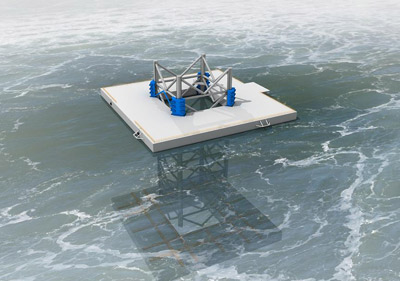 CALM OCEAN 101 will look like nothing else at sea: a broad, square deck surrounding a lone open-truss square jackup leg measuring 20 meters on each side. Image credit: Calm Ocean
CALM OCEAN 101 will look like nothing else at sea: a broad, square deck surrounding a lone open-truss square jackup leg measuring 20 meters on each side. Image credit: Calm Ocean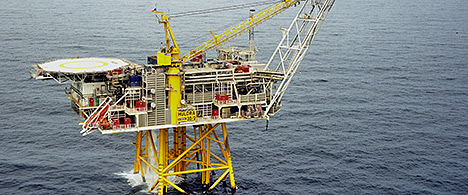 Hereema Marine Contractors Nederland SE will remove the platform and transport it to shore, while AF Offshore Decom AS has been awarded the contract for disposal and recycling of the platform.
Hereema Marine Contractors Nederland SE will remove the platform and transport it to shore, while AF Offshore Decom AS has been awarded the contract for disposal and recycling of the platform.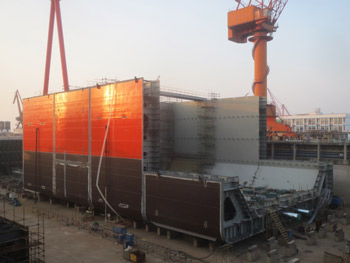 Photo credit: Hydrex
Photo credit: Hydrex Wood Group Intetech (WGI)
Wood Group Intetech (WGI)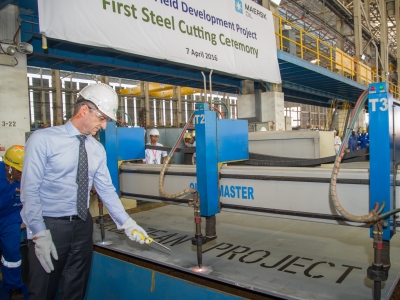 Jakob Thomasen, CEO of Maersk Oil, igniting the flames for the steel-cutting ceremony. This is the first sheet of steel cut for the Culzean megaproject. Credit: Maersk Oil
Jakob Thomasen, CEO of Maersk Oil, igniting the flames for the steel-cutting ceremony. This is the first sheet of steel cut for the Culzean megaproject. Credit: Maersk Oil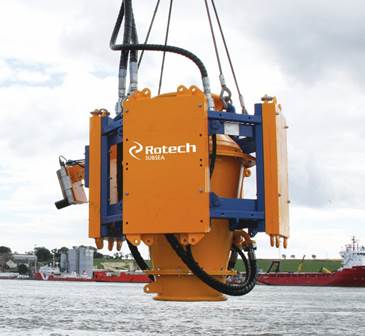 Rotech Subsea RS excavation tool, as fitted with a Tritech Gemini NBI. Image courtesy of Rotech Group Ltd
Rotech Subsea RS excavation tool, as fitted with a Tritech Gemini NBI. Image courtesy of Rotech Group Ltd In a period of cost constraint and increasingly complex oil & gas production, finding solutions that increase efficiency and production has never been more important. To address the industry’s need for smart solutions that reduce complexity,
In a period of cost constraint and increasingly complex oil & gas production, finding solutions that increase efficiency and production has never been more important. To address the industry’s need for smart solutions that reduce complexity,  Aker Solutions
Aker Solutions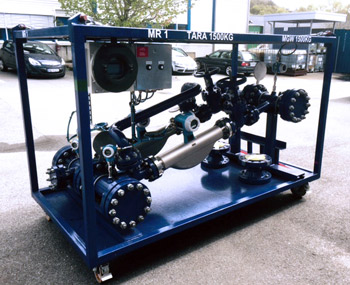 Photo credit: Intertek
Photo credit: Intertek ITF CEO, Dr. Patrick O’Brien
ITF CEO, Dr. Patrick O’Brien Latin American Light Product Imports Level Off/Decline
Latin American Light Product Imports Level Off/Decline Secretary of the Interior Sally Jewell and Director of the Bureau of Safety and Environmental Enforcement Brian Salerno have announced final well control regulations to reduce the risk of an offshore oil or gas blowout that could result in the loss of life, serious injuries or substantial harm to the environment. The regulations represent one of the most significant safety and environmental protection reforms the Interior Department has undertaken since Deepwater Horizon, and builds upon a number of reforms instituted over the last six years to strengthen and modernize offshore energy standards and oversight.
Secretary of the Interior Sally Jewell and Director of the Bureau of Safety and Environmental Enforcement Brian Salerno have announced final well control regulations to reduce the risk of an offshore oil or gas blowout that could result in the loss of life, serious injuries or substantial harm to the environment. The regulations represent one of the most significant safety and environmental protection reforms the Interior Department has undertaken since Deepwater Horizon, and builds upon a number of reforms instituted over the last six years to strengthen and modernize offshore energy standards and oversight.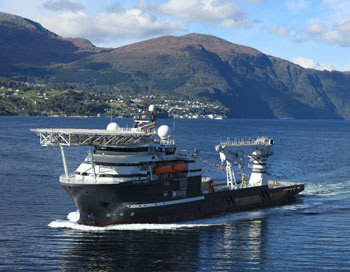 Olympic Ares. Photo credit: Bibby Offshore
Olympic Ares. Photo credit: Bibby Offshore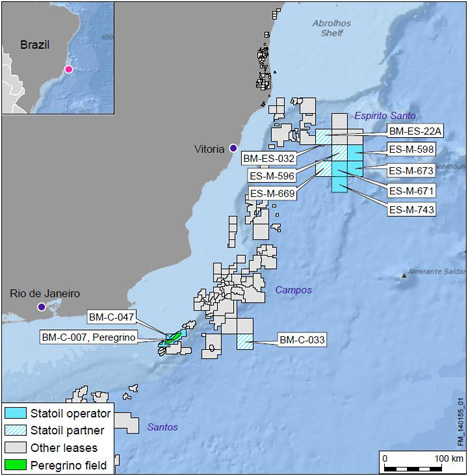
 In 2015, Russian onshore drilling bucked global activity trends and reached record highs. Depreciation of the rouble cushioned the Russian oil industry, incentivizing operators to boost activity and pay for services in roubles while gaining dollars on international markets. Last year, the global number of onshore wells drilled decreased 31%, yet the Russian market – notable for its comparative resilience – experienced year–on–year growth of 6%.
In 2015, Russian onshore drilling bucked global activity trends and reached record highs. Depreciation of the rouble cushioned the Russian oil industry, incentivizing operators to boost activity and pay for services in roubles while gaining dollars on international markets. Last year, the global number of onshore wells drilled decreased 31%, yet the Russian market – notable for its comparative resilience – experienced year–on–year growth of 6%. Amec Foster Wheeler
Amec Foster Wheeler